when you want, where you want.
CJ Television
Museums shouldn’t feel like artifacts, KC firm says; Here’s how Multistudio uses analog experiences to build buzz
Multistudio doesn’t exclusively design museums, but the Westport-based architecture firm — along with Kansas City itself — certainly is having a museum moment, shared Robert Riccardi.
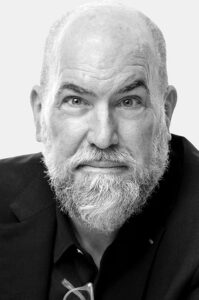
Robert Riccardi, Multistudio
The firm’s local portfolio includes a growing number of new-era museums, including The Rabbit Hole, the Laugh-O-gram animation studio, and the Satchel Paige House.
They’re not your traditional museums with simple glass-box exhibits and signs to read, Riccardi continued. While bringing stories to life, the spaces are hands-on, meant to be occupied, and community-oriented.
“We’re all getting ready for company to come in two years with the World Cup,” the Multistudio principal explained. “I think people are really trying to prepare for the innumerable guests that are going to be joining us for however long and just really highlighting the stories about our place.”
“Kansas City is pretty cool right now from all the press that we’re getting,” he added. “And it’s really capitalizing on that.”
The inquisitive nature of the Multistudio team lends itself well to museum projects that require a different kind of architectural lens, Riccardi noted.
“That’s what I value the most,” he said. “It’s less about hero design, which is great. I’m a designer at heart, but this community impact work and being able to be a part of the process as a partner to get things executed is actually — of course, it’s always fulfilling — but it may be even more so.”
“When we seek out the people with whom we want to work — who share similar values and want to tell stories in an intriguing way that do have community impact and do have great things to tell — it becomes easier and it makes the longer hours really worth it,” Riccardi added.
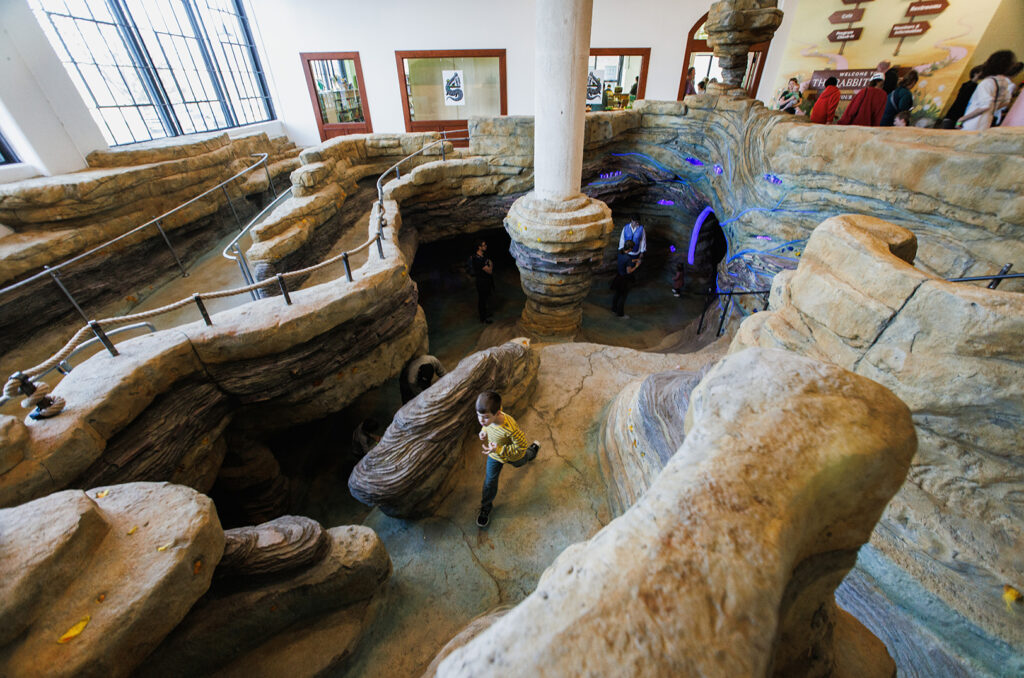
A boy plays in the burrow-esque entrance to The Rabbit Hole in Kansas City, Missouri; photo by Chase Castor for The New York Times
‘Perfectly crooked’
The Rabbit Hole — an immersive children’s literature museum that opened this spring in North Kansas City — provided a unique experience for the Multistudio team, Riccardi shared.
“There’s nothing like that in the country,” he explained. “There’s some things that come close like the City Museum in St. Louis or some of the Meow Wolf spaces. But it’s such a unique opportunity and it’s so special for us to have this here in Kansas City.”
When his 13-year-old daughter visited the museum for the first time, Riccardi recalled, she said it was her childhood come to life.
“This is far more experiential than going to to read placards or to interface with some kind of digital component,” he continued. “The idea of this being full analog is super unique in contemporary museum planning, where the scale is leaning far more to digital interface and the ability to tell stories through screens or AI or VR, however you want to characterize it. That’s the different immersion and this is far more tactile and more hands on as opposed to hands off.”
“There are benches built into the exhibitry,” Riccardi added. “There’s books from the various stories just strewn around. The coolest thing is just seeing people squatting on the floor reading books to their kids.”
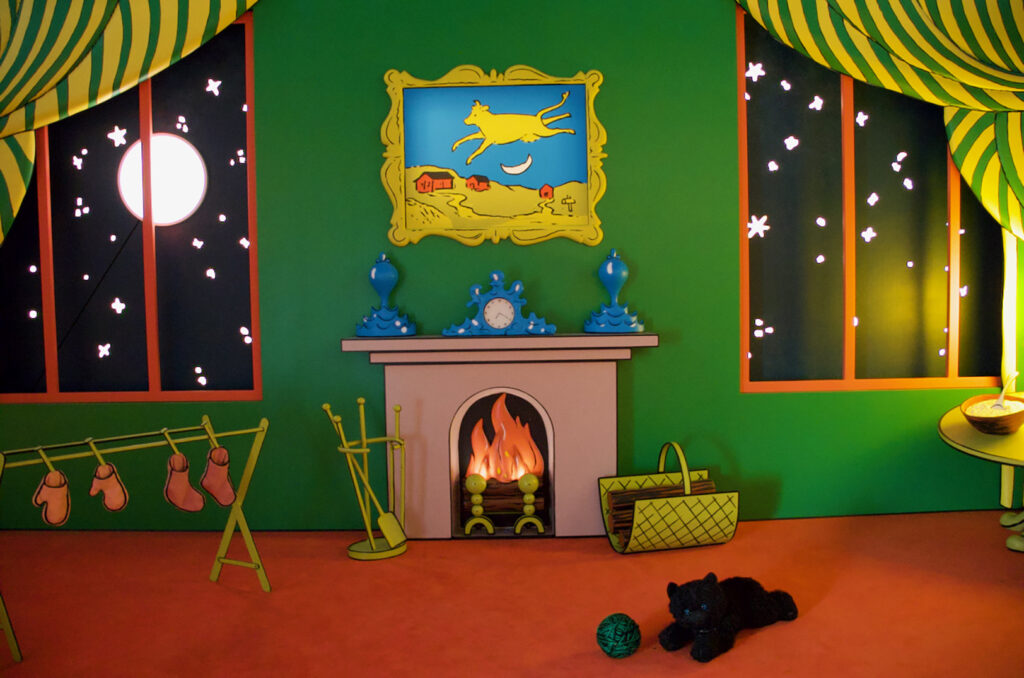
Founders Pete Cowdin and Deb Pettid already had a vision, Riccardi noted, so they weren’t looking for another creative partner when working with Multistudio. All the museum’s exhibits are designed and built by The Rabbit Hole’s in-house team of more than two dozen artists and fabricators. Multistudio’s team was responsible for the architecture and acted as an advisor for questions around materials and circulation.
“It quickly became apparent that our job was in a support role to ensure that their vision materialize safely, economically, etc.,” he continued. “It really was a partnership.”
“We asked for a lot of considerations, back-and-forth, and problem-solving that were outside the norm,” added co-founder Pettid in a news release. “Multistudio has been a patient and creative partner in helping us realize an unprecedented architectural space to match our unique vision for the museum’s exhibits and bespoke programming areas.”

The four-story, century-old industrial warehouse — a former paint factory — has amazing bones and was the perfect framework to just fill in, Riccardi said. It was built robustly with thick concrete floors, concrete mushroom capital columns, and high ceilings.
“We weren’t trying to clean up the building because the beauty of it is in its idiosyncrasies,” he explained. “It wasn’t a perfect space for a perfect museum. We weren’t creating the Bloch Building at the Nelson Atkins. So we knew that going in. A lot of what we do as architects — foundationally — is just to get things to line up, to be ordered, and have a rationale behind things. And in this case, we had to kind of park that a little bit because I like to say, ‘It’s perfectly crooked.’”
Also, unlike other projects, Riccardi noted, The Rabbit Hole doesn’t exactly have a finish date … because the founders plan to keep adding to the museum.
“It allows for this thing to evolve over time,” he added. “This thing is going to go on at meander as they get more money, as they get more stories that they want to tell.”
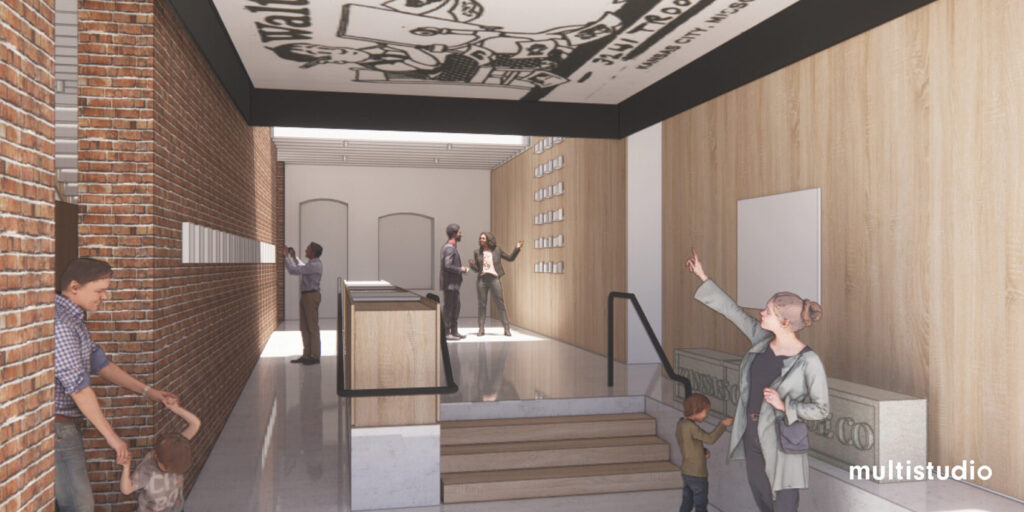
Rendering of the Laugh-O-gram animation studio project; courtesy of Multistudio
When the ‘cool factor’ isn’t enough
The redevelopment of Walt Disney’s original Laugh-O-gram animation studios at 31st Street and Forest Avenue provides Multistudio the challenge of shoring up a dilapidated building and turning it into more than just a museum, Riccardi shared.
“That’s effectively the birthplace of animation as we know it,” he said. “People who worked in that studio were Hanna Barbera, the folks from Looney Tunes, and, of course, the Disney folks, as well. So it literally was the seminal spot for, not only international animation, but certainly local.”
The biggest challenge has been working with a building that is “as close to falling down or being torn down as humanly possible,” he noted.
“There’s the practicality of making sure that it’s stable,” Riccardi continued. “It’s been reinforced to the point that now there’s no fear of it falling down.”
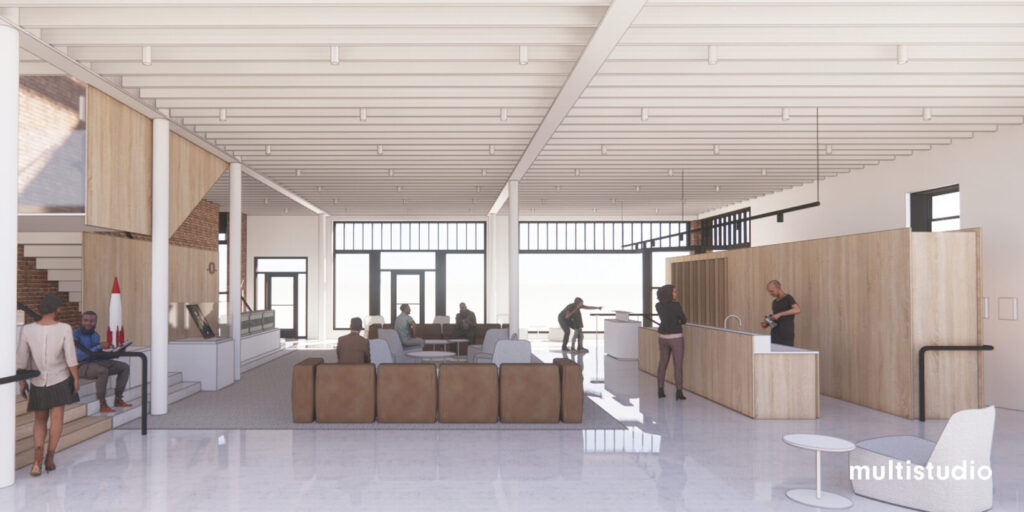
The already-tenuous process was set back by a year when the building was hit by a drunk driver, he explained.
“We’re back to a good, stable place,” Riccardi added.
The Multistudio has also been working with the Thank You Walt Disney nonprofit — which received a $2 million grant to kickstart the project in early 2023 — to turn the space into an enterprise, not just a museum, he said.
“We realize the world is littered with these smaller museums that have the best of intentions,” Riccardi continued, “and they’re really doing important educational pieces for their respective communities. But they can’t live on 17 people a week coming in paying $7. It’s not sustainable, despite the merit of the story, despite the cool factor and all that.”
The redeveloped Laugh-O-gram studios will have a museum element and a community component, he explained. The plans include a coworking space, a digital media training studio, and movie theater on top of an interactive museum.
“I has a 16-hour life in the day of it,” he added. “We’re really interested in this hybridization of programs because any one of those can’t sustain itself — but combined — they outkick their coverage.”
Riccardi also is looking forward to how Laugh-O-gram will contribute to the renewed energy along Troost Avenue.
“We’re really excited about it plugging into that larger ecosystem on a neighborhood level,” he added, “but then also the ecosystem of civic museums from the scale of the World War I museum or the Nelson to some of the other smaller things around town.”
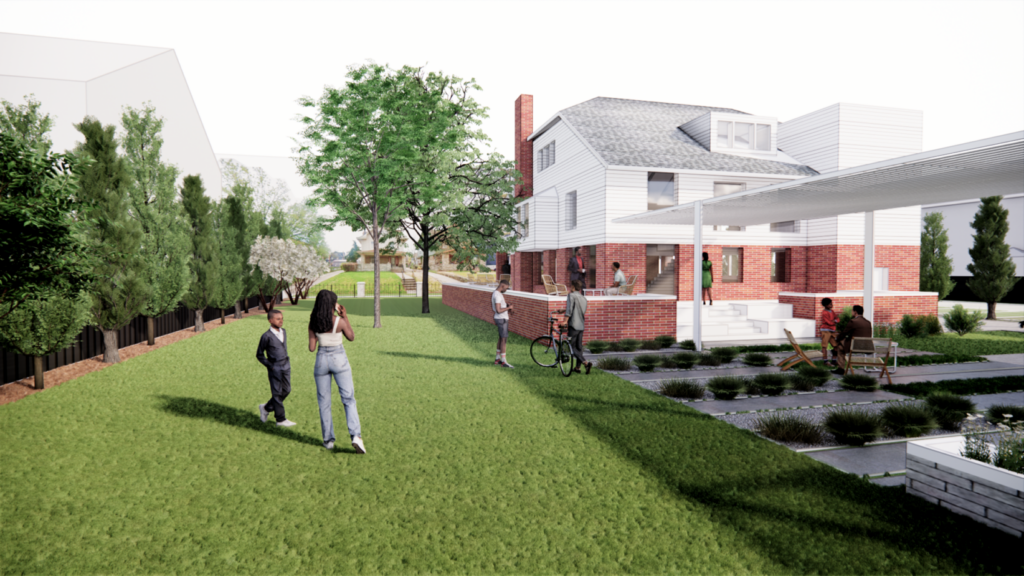
Rendering of the Satchel Paige House; courtesy of Multistudio
Home plate for a history maker
Restoring the family home of Kansas City Monarchs legend Satchel Paige is a personal mission for Riccardi, he shared. About four years ago, he organized a team — Pitch Perfect KC — to pitch his winning strategy to the city.
“Satchel Paige is arguably one of the top five baseball players of all time, irrespective of position or era, and an amazing ballplayer and human character,” he noted. “As a baseball fan, a history fan, a fan of Kansas City, it was really important.”
Pitching a project like this required Riccardi to put on his developer hat, he noted, instead of his architect hat. Like Laugh-O-gram, the plan for the fire-damaged and abandoned former home includes a museum area plus event and office space to sustain it.
“It wasn’t from the normal playbook,” Riccardi continued. “That’s what we’re finding more and more and more and more is that projects come to life in varying different methodologies. Very rare is it these days that it’s a linear process of what would be traditional solicitation for an architect or design team and then it has this normal rhythm.”

Preserving history in these walls
Multistudio’s recent museum work goes beyond the trio of creative spaces, Riccardi noted. In the Kansas City area, the firm is working with the Negro Leagues Baseball Museum on its development around the original YMCA building — where the league was formed — at the corner of 18th and Paseo. The site is expected to include a museum, hotel, and housing.
From the archives: Why renovated Paseo YMCA now bears the name ‘Buck O’Neil’
“We’re in the infancy in that process, but it’s super cool to be a part of,” he noted. “(Negro Leauges President) Bob Kendrick is amazing. Any time you get to spend with him, it’s easy to drink the Kool-Aid after that.”
In Merriam, the team is also working on the museum for the Walker School — a historic former school for Black students built in 1860, which was the site of Civil Rights litigation that helped set the stage for Brown v. Board of Education.
“It’s currently a church, Riccardi noted. “So we’re renovating the church and restoring it back to the one-room schoolhouse to tell the Civil Rights story that happened there.”
Regionally, the team has worked on the new Frontier Museum at Fort Leavenworth, the Eisenhower Museum in Abilene, and the State Historical Society of Missouri Center in Columbia.
The post Museums shouldn’t feel like artifacts, KC firm says; Here’s how Multistudio uses analog experiences to build buzz appeared first on Startland News.
All Rights Reserved. Copyright , Central Coast Communications, Inc.